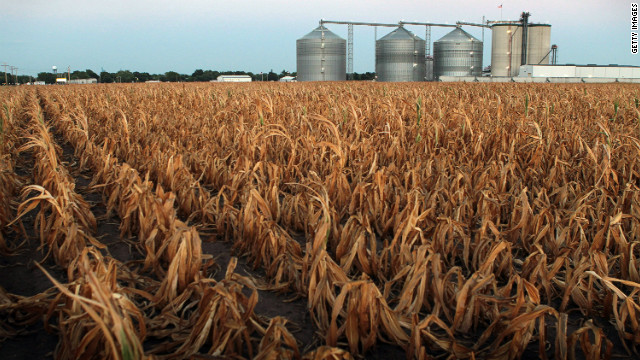Worst drought in US history will bring higher food prices and possible starvation for millions!


Corn fields across Illinois have been devastated by what many are now calling the worst Illinois drought on record. Higher food prices will hit U.S. consumers in 10 months.
July 27, 2012 – CHICAGO – More than 95 percent of Illinois is in a severe drought or worse, according to a national report Thursday that increased concerns about how the hot, dry summer is affecting farming. Most of Cook County is in a moderate drought, and other parts of the Chicago area are suffering through severe drought. But the central and southern portions of Illinois are experiencing even worse conditions that are classified as extreme or exceptional, according to the National Drought Mitigation Center. “In a lot of places in Illinois, this is the worst they remember,” said Emerson Nafziger, a professor of crop sciences at the University of Illinois. About 66 percent of the state’s corn crop is in poor to very poor condition, according to a report his week from the Illinois Department of Agriculture. In states that are major producers of corn nationwide, about 45 percent of the corn is poor or worse, though the total produced this year won’t be known until after September, when harvesting begins, according to the U.S. Department of Agriculture. During the same time last year, only 14 percent of corn crops nationwide were considered poor. Nationally, almost 40 percent of agricultural land is experiencing at least a severe drought, which makes the 2012 drought more extensive than any other since the 1950s, according to the USDA. Illinois Climatologist Jim Angel said July’s heat and lack of rain could make this drought its worst on record, especially because all across the state, farmers’ soil is showing signs of having very little moisture, something essential for plant health. Less corn production usually means higher food prices, according to the USDA, though the full effect of a sparse corn harvest wouldn’t move through to grocery stores until at least 10 months from now. But grocery shoppers could see the price of chicken or eggs and other meats increase sooner than that, since farmers often scale back on their livestock when the cost of corn feed is high, which can happen when corn production is low, Nafziger said. –Chicago Tribune


No comments:
Post a Comment